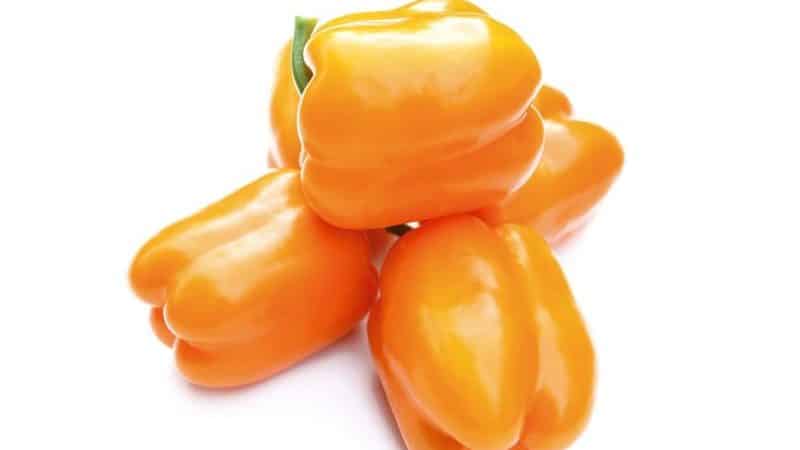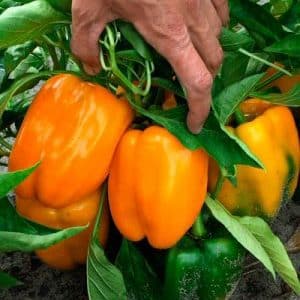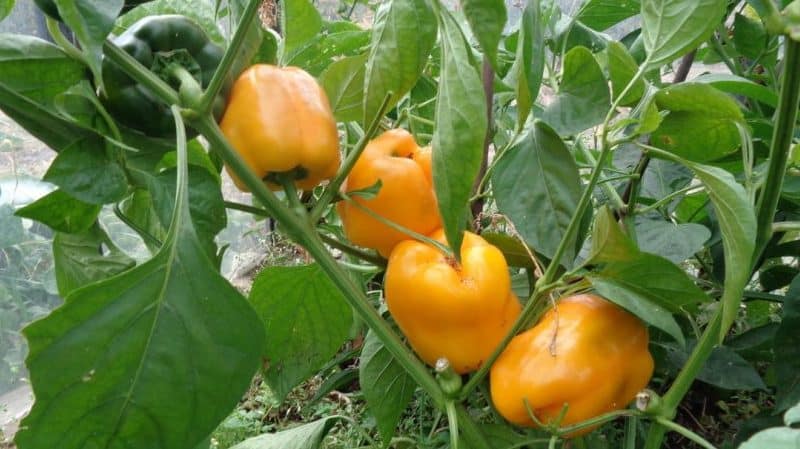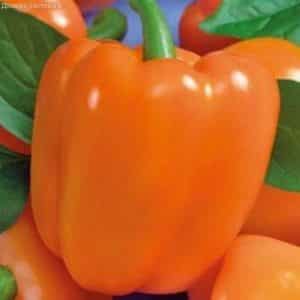A hybrid that will not leave you indifferent - the “Orange Miracle” pepper and the features of its cultivation
Sweet bell peppers are especially popular among gardeners. Large fruits with a lot of pulp, sweet taste without bitterness, possibility use in winter preparations - this is only a small part of the reasons why summer residents love this vegetable.
Among the most popular hybrids is the Orange Heart pepper. The crop is characterized by high productivity and stable immunity to diseases. How to grow peppers on your site and not be disappointed in the choice - read on.
What type of pepper is this?
Orange Miracle F1 is a first generation hybrid. It was included in the Russian state register in 2007.
Since then, the crop has been in steady demand among gardeners. It is produced by the manufacturers “Aelita”, “Sedek”, “Semko”.
Attention! Some companies called Orange Miracle produce another bush pepper. It has a pungent taste and completely different characteristics. Before purchasing seeds, it is important to carefully read the information on the packaging.

Distinctive features
The orange miracle is the bell pepper. Its main feature is considered to be bright, juicy, large, cuboid-shaped fruits. They have a bright orange color inside and out, with a glossy skin. The taste of pepper is sweet, with a slight refreshing sourness. The aroma is rich. There is no bitterness even at the stage of technical maturity.
Another distinctive feature of the hybrid is its high yield. Although the seeds from the fruit are not suitable for planting, it is beneficial plant even for sale.
The orange miracle has high immunity. It is not afraid of either viral or fungal diseases, which greatly simplifies plant care.
Peppers contain large amounts of beta-carotene. This makes the vegetable especially useful for children and people suffering from vitamin deficiency.
The negative features of the hybrid include the lack of cold resistance. It is recommended for cultivation in a greenhouse. Growing in open ground is possible only in regions with a hot climate.
Hybrid characteristics
The description of the Orange Miracle on the packaging fully corresponds to the real characteristics. Its fruits turn out shiny and beautiful, as in the photo. But it is not only the beauty of the fruit that makes the hybrid so popular.
We suggest evaluating the remaining characteristics using the table:
| Parameter | Indicators |
| Bush type | Tall. It reaches a height of 1 m. The stems are powerful and durable. Belongs to the shrub type. The bushes are not very spreading, compact. The leaves are dark green, medium-sized, slightly wrinkled. They are formed on the plant in large quantities. |
| Growing method | Warm-loving culture. Recommended for growing in greenhouses. In the southern regions, planting in open ground is possible. |
| Productivity | High. From 1 sq. m get up to 15 kg of fruit. |
| Fruit | Large ones. On average, the weight of each of them varies between 150–250 g. The weight of individual specimens reaches 300 g. The color of the fruit is bright orange. The skin is glossy. Cuboid shape. On average, one pepper reaches 10 cm in length and 9 cm in width. There is pronounced ribbing on both sides, which spreads across the entire plane. Wall thickness 7–9 mm. The pulp has a richly sweet taste, with a slight sourness and peppery aroma. |
| Transportability | High.Peppers can be stored for more than a month and are suitable for transportation over long distances. |
| Ripening time | Belongs to early ripening varieties. The first fruits ripen 105–115 days after sowing the seeds. |
| Disease resistance | Has immunity to fungal and viral diseases. |
Preparation for cultivation
Before using seeds, they must be prepared. Planting material is sorted, removing darkened and damaged specimens, and disinfected by soaking in one of the following products:
- hydrogen peroxide – 15 minutes;
- light pink solution of potassium permanganate – 20 minutes;
- “Fitosporin” – 6 hours;
- aloe juice, diluted in half with water – 12 hours;
- solution of 1 tsp soda in a glass of water – 12 tsp.
After this, the seeds are germinated. They do this in the following way:
- The seeds are soaked for 5 hours in water at a temperature of 40°C. It is important to ensure that the temperature of the liquid does not fall below this mark.
- After this, the seeds are wrapped in damp gauze, placed in a saucer, covered with film and placed in a warm place for 2-3 days. All this time, the material is regularly moistened with warm liquid.
After this time, the seeds should swell and hatch. This is a sign that the planting material is ready for planting.
Before planting the pepper in a permanent place, seedlings are grown. Otherwise, the plant will not have time to harvest before frost.
In addition to seeds, to grow seedlings you need to prepare the following materials:
- Containers. It is better to use individual peat tablets or pots right away. If this is not possible, the seeds are first planted in a common box, and then the grown seedlings are planted in individual pots.
- Priming. A commercial soil mixture for seedlings and peppers is suitable.You can prepare the soil yourself by mixing garden soil, humus and sand in equal proportions.
- Dark pink solution of potassium permanganate. It is used to disinfect containers, soil and drainage.
- Drainage. Coarse sand, broken ceramics, crushed expanded clay or small crushed stone are suitable.
Growing seedlings
Seeds for seedlings are sown in early March or late February. 80 days should pass from sowing the planting material to planting the pepper in the ground.
Advice! According to gardeners, when grown in a greenhouse, seedlings are stronger and more viable.
Planting pepper
Peppers are sown either directly in individual pots or in a common box.
Instructions for each option:
- Box. A 3 cm layer of sand is poured onto the bottom of the container. Soil is poured on top. It is watered with warm water or a growth stimulator. Grooves 2 cm deep are made in the soil. Seeds are laid out in them, between which there should be a distance of 3 cm from all corners. The crops are covered with earth, covered with film and placed in a warm place.
- Individual pots. They are filled with soil, drainage and watered with warm water. 2 seeds are buried 2 cm in each container. After germination, the weaker stem is pinched. The pots are covered with film and put in a warm place.
- Peat tablets. The blanks are placed in a deep container with the hole facing down. They are poured with boiling water and left until they swell. Then 1 seed is planted in each tablet. The blanks with seeds are covered with film and put in a warm place.
Further care
Frail sprouts need especially careful care. Otherwise, you will not be able to get healthy plants.
Care instructions:
- After the first shoots appear, the greenhouse is dismantled. The seedlings are moved to the windowsill.Pepper is a heat-loving crop, so additional illumination with a fluorescent lamp is often necessary.

- If fluorescent lamps are not used, then the pots with plants are turned daily. This will prevent the pepper from leaning to one side.
- If the seeds are sown in a common container, then after the appearance of two true leaves, the pepper is planted in individual pots. If seedlings are immediately started to be grown in individual pots, then the weaker plant is pinched.
- During the entire period of growing seedlings, they are fed 2 times. The first - 14 days after picking the plants, the second - 5 days before planting in a permanent place. They use purchased preparations “Krepysh” or homemade nutritional supplements (mullein solution, ash, vermicompost).
Features of growing the variety and possible difficulties
Pepper Orange Miracle feels best in greenhouses. In the southern regions it is also possible to grow it in open ground.
Since the variety is heat-loving, for the first two weeks after planting in open ground it must be covered with film at night, protecting it from frost. On cold days this is done even during the day.
Pepper has a powerful main stem. It is not necessary to tie it up, but many gardeners still prefer to attach plants to a support.
The plant requires watering. The soil needs to be moistened at least three times a week. Water is poured not only at the roots. The bushes are sprayed with it. Use only settled liquid at room temperature.
To get a good harvest, peppers need to be fed at least three times during the entire growing period. The first time is 14 days after picking, the second time during the formation of inflorescences, the third time when the fruits ripen. Use complex fertilizers.For the first time, they should contain nitrogen, but the rest of the fertilizers should contain a minimum amount of this substance.
Landing in a permanent place
For peppers, choose beds in the sunniest part of the garden. No other nightshade crops should grow on them the year before.
Peppers of different varieties and hybrids are not planted in adjacent beds. They tend to cross-pollinate.
In the fall, they begin to prepare the beds. They are dug up and cleared of weeds. For 1 sq. m add 6 kg of rotted manure or humus.
Advice! It is easy to measure the acidity of the soil with litmus paper. If the indicator is above 4%, then add dry lime.
In spring, the beds are leveled with a rake and cleared of weeds. The soil is watered with hot copper sulfate.
In greenhouses, the soil on which peppers were previously grown is replaced with new soil. It must also be disinfected.
Holes for pepper are dug in rows in a checkerboard pattern. Use a 50x50 scheme. For 1 sq. m can accommodate up to 4 plants.
1 liter of water is poured into each well. After it is absorbed, add 1 tbsp. l. ash and long-acting complex mineral fertilizers.
The holes with pepper are covered with soil. The root collar of the plants is not buried.
Rules of care

To get healthy plants and a bountiful harvest, it is important to follow the basic rules for growing this crop:
- In order for the pepper to feel good, it is sprayed several times a season with boric acid or a product prepared from a bucket of water and 1 tbsp. l. nitrophoska.
- Pepper loves spraying, but this should not be done during the flowering period. Otherwise, the pollen will clump together and pollination will not occur.
- To speed up pollination, pepper beds are sprayed with sweet water. It will attract beneficial insects.
- Excess leaves from the bottom of the bush must be removed. The procedure is carried out once a week, removing no more than three leaves.
- To get a rich harvest, the fruits are harvested at the stage of technical maturity. They will ripen at home. Having gotten rid of the fruits, the pepper begins to form new stepsons with the harvest.
- The beds must be covered with mulch (straw, hay, peat). This layer will protect plants from diseases, pests, cold and drought.
- After each watering, the soil is loosened and weeds are removed - they damage and inhibit the root system of the pepper.
- If additional roots form on the stems, they are sprinkled with earth.
Typical diseases and pests
Orange miracle pepper has strong immunity to fungal and viral diseases. Therefore, the plant is not sprayed with chemicals for preventive purposes.
It is important to protect peppers from insects. They damage bushes and crops, and also spread infections:
- A decoction of wormwood will protect against small pests such as aphids and spider mites. If pests have already infested the bushes, then they are sprayed with a soap solution prepared from a bucket of water and a grated piece of laundry soap.
- The Barrier protects against the Colorado potato beetle. Large pests are also collected manually.
- To get rid of slugs, just spray the plants with a product made from a bucket of water and a few crushed hot peppers.
To prevent plants from getting sick, you need to follow the rules of prevention: care and adherence to the principles of crop rotation, ventilation of the greenhouse.
Advantages and disadvantages of a hybrid
Benefits of the Orange Miracle:
- immunity to nightshade diseases;
- high productivity;
- bright and tasty fruits;
- increased content of nutrients in peppers;
- lack of stepsoning.
The disadvantage is considered to be hybridity and instability to cold weather.
Reviews
Pepper Orange Miracle has many good reviews. This hybrid is popular due to its good taste and high yield.
Larisa, Perm: «I have been growing Orange Miracle peppers in a greenhouse for several years now. A very productive hybrid. It does not get sick and does not require shaping, so it is easy to care for. The main thing is to water the plantings regularly and do not forget to feed them. I use silage, superphosphate and ash. The fruits are beautiful and large: just what you need for salads.”
Tatyana, Solnechnogorsk: “Last year, a friend shared the seeds of the Orange miracle. This is now my favorite hybrid. I really liked the large, bright, thick-walled peppers. They are ideal for salads and lecho. The harvest is very large. There was even enough to freeze it. I freeze the peppers whole, removing the seeds. Then we eat our stuffed peppers all winter.”
Read also:
Fertile Hercules pepper, disease-resistant and easy to care for.
A unique variety with a rich harvest and excellent taste is Ivanhoe pepper.
A variety that may become your favorite is the Ox's Ear pepper.
Conclusion
Few varieties can compete in popularity with the Orange Miracle pepper. This hybrid is characterized by high yield and beautiful, tasty fruits.
Growing peppers is easy. He is not afraid of diseases and does not require formation. The main thing is to protect it from low temperatures, water it regularly and feed it in a timely manner.
When buying seeds called Orange Miracle, pay attention to the characteristics and description. Otherwise, there is a possibility of getting a hot pepper with the same name instead of a sweet, fleshy bell pepper.